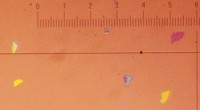Nobel Prize in Physics 2010

This year’s Nobel Prize in Physics was awarded to Prof. Andre Geimand and Dr Konstantin Novoselov from the University of Manchester, for their experimental isolation of graphene, a layer of graphite just 1 atom thick (KS Novoselov et al., Science 306, 666 (2004)).
This breakthrough consisted of depositing thin layers of graphite on silicon, then peeling successive atomic layers off with Scotch tape until only 1 layer remained. The technique produces a small number of crystals of monolayer graphene surrounded by a large number of thicker crystallites (see photo), but it was possible to identify the single atomic layers with the naked eye in an optical microscope, provided that the correct thickness of SiO2 had been deposited on the Silicon substrate.
The explosion of scientific interest in graphene which followed was due to its unique electronic bandstructure in which the electrons behave as massless Dirac Fermions, mimicking relativistic particles. The quantum Hall effect and ballistic transport have been observed in graphene at room temperature, leading to its development for a wide variety of applications in electronics. Its high surface-area-to-volume ratio and strength are leading to applications in materials science and surface science.
Recently, researchers from the University of Edinburgh’s Centre for Science at Extreme Conditions (CSEC) and the School of Physics have been collaborating with Dr. Novoselov to produce the first study of graphene under hydrostatic pressure (JE Proctor, E Gregoryanz, KS Novoselov, M Lotya, JN Coleman and MP Halsall, Phys. Rev. B 80, 073408 (2009)).
The importance of this work lies in graphene’s potential applications in electronics (for which the changes to the electronic bandstructure caused by strain are important), and graphene’s proposed applications as an ultra-sensitive strain sensor.
The work is an example of the application of CSEC’s world-leading expertise in high pressure science to the study of novel and technologically important materials, to gain important and fundamental information about these materials.

